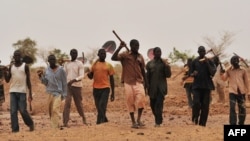DAKAR —
The World Bank says it wants to double the amount of irrigated land in Africa's Sahel region in the next five years. Experts say that could make a huge difference for both farmers and herders.
The Sahel has been trapped in a downward spiral of recurrent food crises and deepening poverty over the past decade. Agriculture and economic experts say irrigation could play a big role in turning it all around.
“As you know, most agriculture in the Sahel is rain-fed agriculture and we have very erratic rain patterns - which means that the productivity of land is not at a level we could expect. So if we want to reduce poverty in our region," said Mahktar Diop, the World Bank’s vice president for Africa. "We need to make sure that people in the rural space have an opportunity to have a stable income, to increase their income. And looking at the Sahel, in the rural space, the two main activities are agriculture and livestock.”
For both of those activities, you need water.
The World Bank says that right now, only 19 percent of the land in the Sahel that could be irrigated is being irrigated, and a quarter of the irrigation systems in place are not working properly.
Diop said that irrigation can improve crop yields and ensure that grazing livestock have enough to eat and drink.
Better water management systems can also insulate both farmers and herders against the impacts of climate change and what have become increasingly frequent extreme weather events, like droughts and flooding.
The World Bank says its goal is to double the amount of irrigated land in the next five years, but that it is up to governments in the region to get on board.
The Sahel has been trapped in a downward spiral of recurrent food crises and deepening poverty over the past decade. Agriculture and economic experts say irrigation could play a big role in turning it all around.
“As you know, most agriculture in the Sahel is rain-fed agriculture and we have very erratic rain patterns - which means that the productivity of land is not at a level we could expect. So if we want to reduce poverty in our region," said Mahktar Diop, the World Bank’s vice president for Africa. "We need to make sure that people in the rural space have an opportunity to have a stable income, to increase their income. And looking at the Sahel, in the rural space, the two main activities are agriculture and livestock.”
For both of those activities, you need water.
The World Bank says that right now, only 19 percent of the land in the Sahel that could be irrigated is being irrigated, and a quarter of the irrigation systems in place are not working properly.
Diop said that irrigation can improve crop yields and ensure that grazing livestock have enough to eat and drink.
Better water management systems can also insulate both farmers and herders against the impacts of climate change and what have become increasingly frequent extreme weather events, like droughts and flooding.
The World Bank says its goal is to double the amount of irrigated land in the next five years, but that it is up to governments in the region to get on board.








